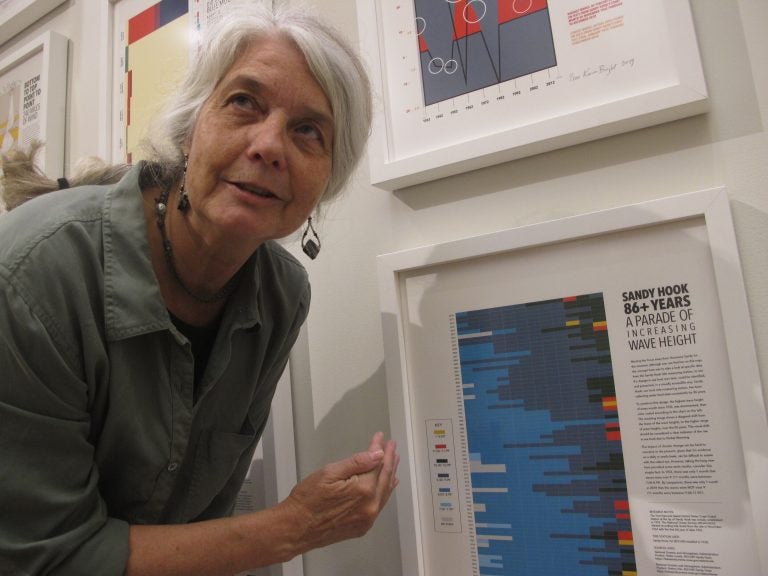Survivors’ tales part of the art in Superstorm Sandy exhibit
The "Just Beachy After Sandy" exhibit at Monmouth University in New Jersey is on display through early December.

This Oct. 21, 2019 photo shows Karen Bright, a professor at Monmouth University, with a Superstorm Sandy-themed art exhibit she and another professor created in West Long Branch, N.J. Personal stories of people who survived Superstorm Sandy are an integral part of a new art exhibit remembering the deadly storm and the devastation it caused. (Wayne Parry/AP Photo)
The stories of people who survived Superstorm Sandy, scrawled in their own handwriting, are an integral part of a new art exhibit remembering the deadly storm and the devastation it caused seven years ago.
The “Just Beachy After Sandy” exhibit at Monmouth University in New Jersey is on display through early December. It incorporates people’s survival stories into the artwork, which also includes an obelisk made from slices from trees that fell during the storm.
There are hanging posters resembling beach towels that present Sandy-related data in easy-to-grasp visual terms, and a “climate shelter” where all the trappings of a home that would normally be on the inside — chairs, photographs, drawers — are on the outside, symbolizing the huge mounds of sodden possessions that became refuse and had to be hauled away from the curb after the Oct. 29, 2012, storm. Inside the shelter, a recording of the storm pounding the coast plays on a loop.
It was created by Karen Bright, an art and design professor, and Amanda Stojanov, an assistant professor of communication.

“You mention Sandy around here, and everybody dives right into their story,” Bright said. “It’s right at the tip of their tongue. I thought, ‘How can I make this a communal event?’ I wanted to visualize the data and the reality of the storm in a way that’s more accessible to people.”
The storm was blamed for at least 182 deaths in the U.S. and Caribbean — including 48 in New York and 12 in New Jersey — and more than $71 billion in damage in this country alone.
The heart of the exhibit is the survivors’ stories. Some excerpts:
- “We stayed home for Sandy. Hurricane Irene didn’t affect us a year earlier; why would Sandy be any different? We watched the water rise through the floor boards. An hour in, we lost power. A little later we were forced up to the second floor. The next morning we went to check the damage. It looked like a tornado had gone through our home.” — Sandra Walters, Keansburg, New Jersey.
- “Adrienne, Mike and Alicia decided not to evacuate. They lost power shortly after Sandy hit and, in the dark, they realized that water was rushing into their home. Before they knew it, they had three feet of water. They were too afraid of downed power lines, so they stayed perched on top of furniture until the water receded.” — Mike and family, Port Monmouth, New Jersey.
- “Patricia has been displaced from her home since Sandy. Pat’s family used to spend summers down the shore and when her husband passed, she moved to a bungalow in Keansburg. During Sandy, Pat’s house began to flood and she was forced to stay with family. Her house was demolished.” — Patricia and family, Keansburg, New Jersey.
Bright began working on the project three years ago and has been soliciting storm survivors’ stories since January. The hanging artwork on rectangular canvas, bordered in white, resembles beach towels. It takes Sandy data and visually represents it in ways with an immediate, easy-to-grasp impact.
One uses 86 years of data on wave heights off the New Jersey coast to form a multicolored artwork with an unmistakable surge over the years toward larger waves and bigger storms.
Flotsam and jetsam from the storm are displayed as art in their own right, including lengths of weathered nautical rope and fishing line that she plucked from New Jersey beaches after the storm.
The “climate shelter” is topped with a small geodesic dome that represents temporary shelter. And the walls of prints created by the two professors are designed to be covered up by notes left by Sandy survivors.

The idea is that the power of survival and rebuilding can “erase” the power of the storm and its destruction.
They included tales such as this one from Susan and her family, who lived in Ocean Grove: “We watched as water streams swept past the house as if we were on a moving train.”
A young woman named Lacey from Toms River was attending graduate school in Massachusetts when the storm hit, and she and others came to New Jersey to help with the recovery.
“The homeowners were in varying stages of disbelief, despair and denial. One woman was putting her photos in boxes, like the black mold could be overcome. I wore 3 masks and had to leave every 20 minutes because I was so sick from the mold that pervaded the walls.”
The roller coaster that plunged off an amusement pier in Seaside Heights and sat in the ocean for months became an indelible image of the storm’s destruction. It still figures in many survivors’ memories of Sandy.
“I watched images of the roller coaster I rode as a child float away into the angry sea. It was like my memories were stolen — erased like they never existed at all,” wrote MaryAnn St. Jacques, of Mendham, New Jersey.
Anthony and Beverly, of Highlands, were trapped with their cats in the second floor of their house for two days after the storm. They wrote that they remember watching their refrigerator float through the house.
And the son of a woman with end-stage cancer had this recollection:
“My mother’s cars were pushing up on the second floor, dunes to the ceiling. My mother had stage 4 ovarian cancer; I had to carry her to the door to see for herself. My heart broke that day — I lost it in the dunes. My mother died nine months later. I could never return.”
Follow Wayne Parry at http://twitter.com/WayneParryAC
WHYY is your source for fact-based, in-depth journalism and information. As a nonprofit organization, we rely on financial support from readers like you. Please give today.




